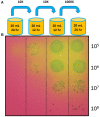Rescue of mutant fitness defects using in vitro reconstituted designer transposons in Mycoplasma mycoides
- PMID: 25101070
- PMCID: PMC4107850
- DOI: 10.3389/fmicb.2014.00369
Rescue of mutant fitness defects using in vitro reconstituted designer transposons in Mycoplasma mycoides
Abstract
With only hundreds of genes contained within their genomes, mycoplasmas have become model organisms for precise understanding of cellular processes, as well as platform organisms for predictable engineering of microbial functions for mission-critical applications. Despite the availability of "whole genome writing" in Mycoplasma mycoides, some traditional methods for genetic engineering are underdeveloped in mycoplasmas. Here we demonstrate two facile transposon-mediated approaches for introducing genes into the synthetic cell based on M. mycoides. The marker-less approach involves preparing a fragment containing only a small genomic region of interest with flanking transposase-binding sites, followed by in vitro transposase loading and introduction into the cells. The marker-driven approach involves cloning an open reading frame (ORF) of interest into a vector containing a marker for mycoplasma transformation, as well as sites for transposase loading and random genomic integration. An innovative feature of this construct is to use a single promoter to express the transformation marker and the introduced ORF. The marker-driven approach can be conveniently applied to any exogenous or synthetic gene without any information on the effect of the gene on the strain, whereas the marker-less approach requires that the fragment has a recognizable effect. Using the marker-less method, we found that a region containing the nusG gene rescues a slow growth phenotype of a strain containing a larger deletion encompassing this gene. Using the marker-driven approach, we better defined this finding, thereby establishing that nusG is required for a normal growth rate in synthetic M. mycoides. These methods are suitable for complementation tests to identify genes responsible for assorted functions lacking in deletion mutants. These approaches are also expected to facilitate rapid testing of various natural and engineered genes or gene clusters from numerous sources in M. mycoides.
Keywords: complementation; minimal cell; nusG; synthetic cell; transposome.
Figures







Similar articles
-
Characterization of a chromosomal region of Mycoplasma sp. bovine group 7 strain PG50 encoding a glycerol transport locus (gtsABC).Microbiology (Reading). 2003 Jan;149(Pt 1):195-204. doi: 10.1099/mic.0.25742-0. Microbiology (Reading). 2003. PMID: 12576593
-
Attenuation of a Pathogenic Mycoplasma Strain by Modification of the obg Gene by Using Synthetic Biology Approaches.mSphere. 2019 May 22;4(3):e00030-19. doi: 10.1128/mSphere.00030-19. mSphere. 2019. PMID: 31118296 Free PMC article.
-
Distinctive repertoire of contingency genes conferring mutation- based phase variation and combinatorial expression of surface lipoproteins in Mycoplasma capricolum subsp. capricolum of the Mycoplasma mycoides phylogenetic cluster.J Bacteriol. 2006 Jul;188(13):4926-41. doi: 10.1128/JB.00252-06. J Bacteriol. 2006. PMID: 16788201 Free PMC article.
-
Taxonomy of the Mycoplasma mycoides cluster.Isr J Med Sci. 1987 Jun;23(6):632-5. Isr J Med Sci. 1987. PMID: 3312102 Review.
-
Investigation of Genome Biology by Synthetic Genome Engineering.Bioengineering (Basel). 2023 Feb 20;10(2):271. doi: 10.3390/bioengineering10020271. Bioengineering (Basel). 2023. PMID: 36829765 Free PMC article. Review.
Cited by
-
Mesoplasma florum: a near-minimal model organism for systems and synthetic biology.Front Genet. 2024 Feb 9;15:1346707. doi: 10.3389/fgene.2024.1346707. eCollection 2024. Front Genet. 2024. PMID: 38404664 Free PMC article. Review.
-
Strategies for cloning and manipulating natural and synthetic chromosomes.Chromosome Res. 2015 Feb;23(1):57-68. doi: 10.1007/s10577-014-9455-3. Chromosome Res. 2015. PMID: 25596826 Review.
-
Robust and highly efficient transformation method for a minimal mycoplasma cell.J Bacteriol. 2025 Mar 20;207(3):e0041524. doi: 10.1128/jb.00415-24. Epub 2025 Feb 4. J Bacteriol. 2025. PMID: 39903184 Free PMC article.
-
Reproduction of contagious caprine pleuropneumonia reveals the ability of convalescent sera to reduce hydrogen peroxide production in vitro.Vet Res. 2019 Feb 8;50(1):10. doi: 10.1186/s13567-019-0628-0. Vet Res. 2019. PMID: 30736863 Free PMC article.
-
Gene editing tools for mycoplasmas: references and future directions for efficient genome manipulation.Front Microbiol. 2023 May 18;14:1191812. doi: 10.3389/fmicb.2023.1191812. eCollection 2023. Front Microbiol. 2023. PMID: 37275127 Free PMC article. Review.
References
LinkOut - more resources
Full Text Sources
Other Literature Sources
Molecular Biology Databases

